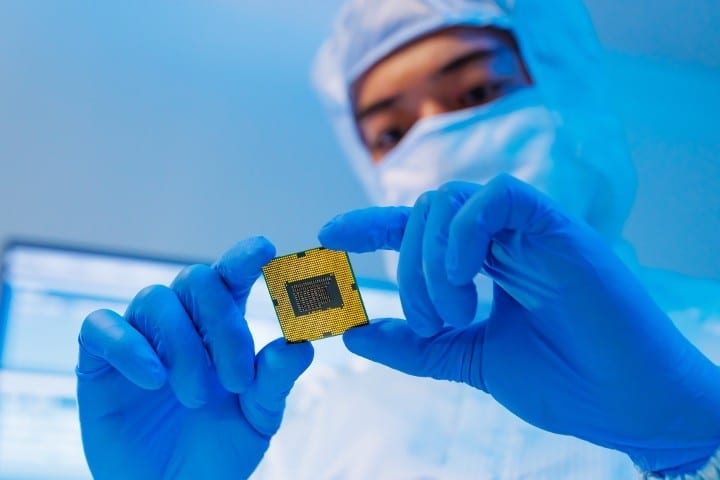
SINGAPORE — Dell Technologies announced its plans to cease relying on China-made chips by 2024 and has informed suppliers to curtail the number of other made-in-China components in its products amid frosty Washington-Beijing tensions, the Nikkei daily reported on January 5.
The computer manufacturer hopes to considerably reduce the amount of China-made chips it uses, including those made at facilities owned by non-Chinese chipmakers, the report continued, quoting three people with firsthand knowledge of the issue.
Dell has also requested that product assemblers and suppliers of other components like electronic modules and printed circuit boards make way for capacity in other countries like Vietnam, the report said.
In the past, computer makers like Dell and HP purchased chips from chip developers without concerns about their manufacturing origins, and the recent change in attitude has surprised some in the industry.
“There are thousands of components for notebook computers, and the ecosystem was so mature and complete in China for years,” remarked an executive at a chip supplier for both Dell and HP. “Previously, we knew Dell kind of had plans to diversify from China, but this time it is kind of radical. They don’t even want their chips to be made in China, citing concerns over the U.S. government’s policy…. It’s not just an evaluation, it’s not crying wolf. It’s a real and ongoing plan, and this trend looks irreversible.”
Dell’s decision comes after the U.S. included Chinese memory-chip maker YMTC and 21 “major” Chinese players in the artificial intelligence chip sector on a trade blacklist in December 2022.
In October 2022 the Biden administration had imposed a series of export restrictions that included a clause to exclude China from some semiconductor chips made anywhere globally with U.S. tools. Consequently, Chinese chipmaker Semiconductor Manufacturing International Corporation (SMIC) declared in November that some of its U.S. chip-developer customers had become cautious about placing orders with the company.
Rising Sino-U.S. tensions have provided an impetus for firms to divert their supply chains away from China. Apple supposedly has a blueprint to begin making its MacBook notebooks in Vietnam by mid-2023, implying that the firm will have some non-China production bases for all of its primary product lines.
PC maker HP, one of Dell’s competitors, has also begun evaluating its suppliers to assess the feasibility of shifting production and assembly away from China, Nikkei said.
Biden’s signing of the CHIPS and Science Act last year marked a significant shift in U.S. policy to make the country more competitive with and not reliant on China’s science and technology efforts.
A $39 billion program under the CHIPS Act will allocate to U.S. or foreign semiconductor manufacturing and research firms grants of up to $3 billion per project to establish or expand their production facilities in the U.S. The act, which aims to raise U.S. competitiveness in advanced manufacturing, bans recipients of federal funds from expanding or overhauling their chip capacity in China.
The act may prompt South Korean tech giants Samsung and SK Hynix, which have plants in China, to halt expansion in China if they receive U.S. federal funds in the future. Both have declared plans for new plants in the United States.
In 2021, China imported more than $400 billion worth of chips, amounting to about 60 percent of the global chip market.
Third-party firms will have to be aware of possible secondary sanctions, depending on how the U.S. pursues the conditions under the CHIPS Act, said analyst Arjun Gargeyas at the Takshashila Institution, a nonprofit research center in India.
Open U.S.-China trade and technology confrontation was catalyzed in 2019 when the Trump administration put Huawei on a trade blacklist due to national security risks, banning or strictly licensing the sale of U.S. goods to the Chinese telecommunications equipment maker.
China retaliated by investing heavily in its advanced manufacturing industry, with SMIC boasting that it can make its own 7-nanometer chips.
Notably, these 7-nanometer chips still trail behind the 3-nanometer chips produced by Samsung and Taiwan Semiconductor Manufacturing Company (TSMC), the world’s largest contract chipmaker, which manufactures 60 percent of the world’s chips.
Following lobbying from the U.S. in 2020, Dutch company ASML, the world’s leading maker of lithography systems vital to creating semiconductors, has been forbidden by the Netherlands from selling its most advanced machines to China. The U.S. stepped up its pressure on the Netherlands to ban ASML from exporting its older models to China as well, to curb China’s technological rise.
The U.S. also blocked Nvidia and Advanced Micro Devices from exporting sophisticated computing chips to China. Officials justified their decision by pointing out that the chips — used in artificial intelligence computing such as image recognition work — could be channeled to “military end use” or “military end users” in China.
Should China be given unbridled access to chips, the U.S. fears that the communist state could surpass its own technological prowess. A report by Georgetown University’s Center for Security and Emerging Technology revealed that America’s efforts at distancing from China, especially when it comes to export restrictions stopping the Chinese from obtaining vital technological know-how, have met with some success in the semiconductor industry.
Dale Gai, research director at Counterpoint Research in Taiwan, said Taiwan’s semiconductor firms are cognizant of the need to diversify to mitigate concerns from customers worldwide amid rising Taiwan Strait hostilities, and although Taiwanese semiconductor firms will keep their bases at home, plans are underway to expand some of their operations overseas.
Enticed by U.S. funding and tax credits, TSMC is setting up a $12 billion 5-nanometer chip fabrication plant in Arizona, where it is poised to begin production in 2024.



